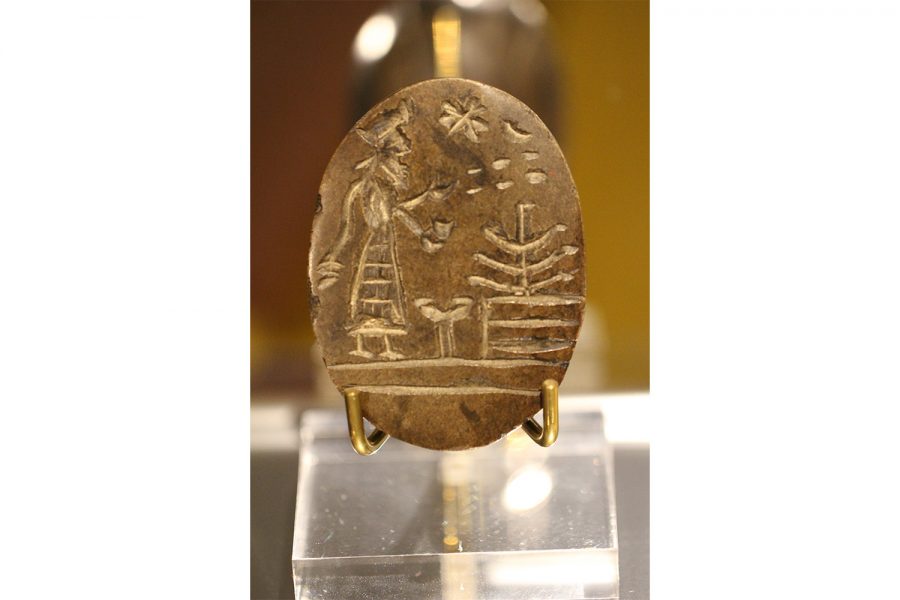Decades-long scheme exposed: UI professor and grad student uncover forged antiquities
A massive forgery scheme has been exposed, and it all began with the discoveries of a University of Iowa art history professor and graduate student when they discovered over 90 fake artifacts in an exhibit at the Hoover museum.
September 2, 2021
Innumerable artifacts forged, thousands of dollars defrauded, and countless individuals and businesses deceived — without the discoveries of a University of Iowa professor and graduate student, it all may never have been unearthed.
In April 2019, Associate Art History professor Björn Anderson and now-third-year graduate student Erin Daly were invited to see the new “Rosetta Stone” exhibit at the Herbert Hoover Presidential Library and Museum in West Branch, Iowa, just days before the exhibit opened to the public.
The exhibit would consist of several artifacts from multiple eras and locations in countries like Egypt, Iraq, and Iran, including statues, pottery, stone tablets, and clay seals inscribed with markings of constellations or deities to imprint on other objects in ancient times.
As soon as they laid eyes on the artifacts carefully labeled and displayed, both Anderson and Daly could tell something was amiss.
Daly was the first to inspect the objects closer, and being an expert on seals, she noticed something off with an Old Babylonian seal that was supposedly from 1920 B.C. The grad student noted the object was unusually large and pristine, and carved in a different style than any other seal Daly had encountered in her career.
“There was already a bit of ambiguity [in the exhibit],” Daly said. “Right away, it seemed to me each seal was made by the same hand, or as we later learned, some sort of workshop.”
When she was certain of her suspicions, she conferred with Anderson, who seconded her opinion.
The professor soon notified the museum via a letter written to Thomas Schwartz, the director of the Hoover Library and Museum. He described that out of the 125 objects in the collection to be displayed, 90 were either definite or very likely fakes. The museum was quick to acknowledge the situation and canceled the opening of the exhibit for further investigation, which Anderson said was not an easy decision.
“They did the right thing, and I give them all the credit in the world for acting quickly and decisively,” Anderson said.
The forged items in the exhibit were all loaned as part of a larger collection from the artifact gallery Origins Museum Institute, which has since taken down its website and catalogues. The gallery’s owner and curator, Marty Martin, denied any knowledge of the forgeries.
RELATED: Pentacrest Museums turn to mapping software to recreate exhibits virtually
Daly soon found that Martin had purchased the objects two decades prior from the Sadigh Gallery, a gallery run by antiquities dealer Mehrdad Sadigh since 1978, out of an office mere blocks from the Empire State Building. When confronted, Sadigh also claimed he “didn’t know anything about this,” according to The West Branch Times, which reported the artifacts investigation in 2019.
Anderson found that the Sadigh Gallery also sold artifacts on a website, now deleted, that appeared extremely suspicious, with multiple listings of duplicate objects and entirely positive customer reviews. He felt obligated to call the FBI soon after this discovery.
“It’s still shocking to me that the website was so comprehensive, he didn’t have any thought that listing the same object several times in different colors would be an obvious sign,” Anderson said.
After taking it to the FBI, which transferred it to the New York County District Attorney’s Office, Anderson and Daly didn’t hear much about the investigation for over two years. Then, in August, they got word that Sadigh had been arrested.
The dealer was charged with grand larceny, criminal possession of a forged instrument, forgery, and criminal simulation. After a raid of the space Sadigh operated out of, it was found that he created thousands of phony antiquities in a few back rooms and offices just beside his display area, which went unnoticed for decades.
In a statement made by the district attorney’s office to The New York Times, it was said that “Sadigh appeared to be among the biggest purveyors of fake artifacts in the country,” based on how long his business ran and the prices at which he sold items, which ranged as high as $50,000 for some false artifacts.
The date for Sadigh’s trial is not yet set, and it is uncertain whether Anderson and Daly will be called to testify.
“It was really gratifying that they got this guy — he’s probably defrauded a lot of stuff,” Anderson said. “It was a huge operation, so it was gratifying that we were able to contribute.”




